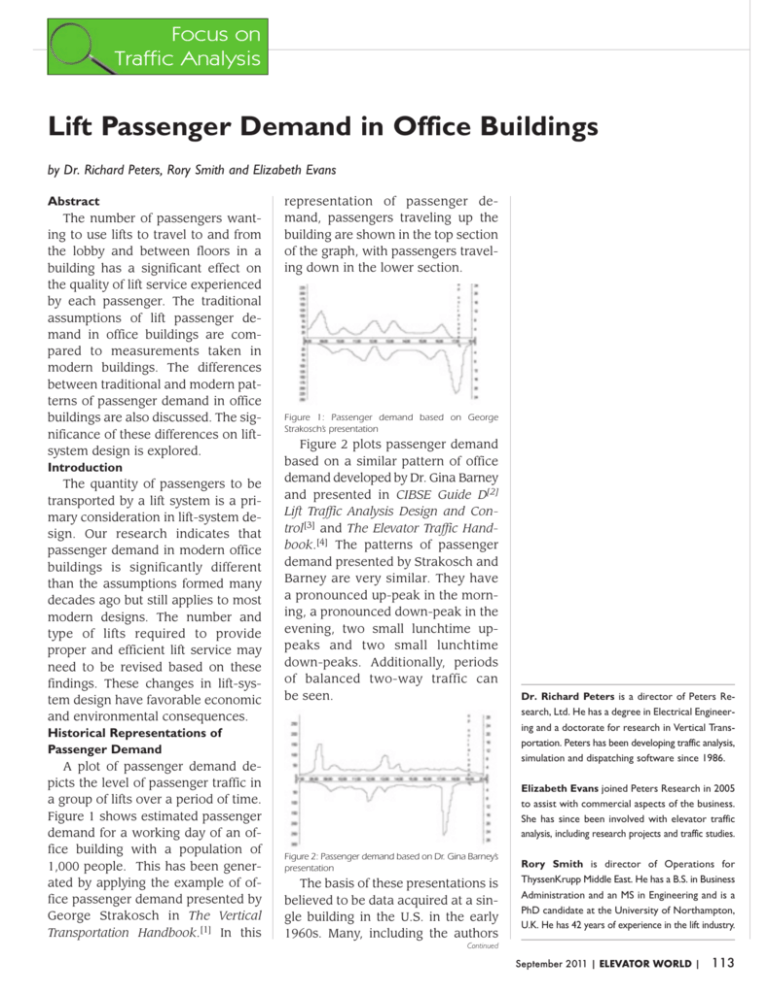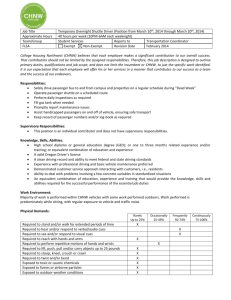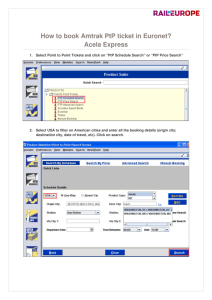Lift Passenger Demand in Office Buildings
advertisement

Focus on Traffic Analysis Lift Passenger Demand in Office Buildings by Dr. Richard Peters, Rory Smith and Elizabeth Evans Abstract The number of passengers wanting to use lifts to travel to and from the lobby and between floors in a building has a significant effect on the quality of lift service experienced by each passenger. The traditional assumptions of lift passenger demand in office buildings are compared to measurements taken in modern buildings. The differences between traditional and modern patterns of passenger demand in office buildings are also discussed. The significance of these differences on liftsystem design is explored. Introduction The quantity of passengers to be transported by a lift system is a primary consideration in lift-system design. Our research indicates that passenger demand in modern office buildings is significantly different than the assumptions formed many decades ago but still applies to most modern designs. The number and type of lifts required to provide proper and efficient lift service may need to be revised based on these findings. These changes in lift-system design have favorable economic and environmental consequences. representation of passenger demand, passengers traveling up the building are shown in the top section of the graph, with passengers traveling down in the lower section. Figure 1: Passenger demand based on George Strakosch’s presentation Figure 2 plots passenger demand based on a similar pattern of office demand developed by Dr. Gina Barney and presented in CIBSE Guide D[2] Lift Traffic Analysis Design and Control[3] and The Elevator Traffic Handbook.[4] The patterns of passenger demand presented by Strakosch and Barney are very similar. They have a pronounced up-peak in the morning, a pronounced down-peak in the evening, two small lunchtime uppeaks and two small lunchtime down-peaks. Additionally, periods of balanced two-way traffic can be seen. Historical Representations of Passenger Demand A plot of passenger demand depicts the level of passenger traffic in a group of lifts over a period of time. Figure 1 shows estimated passenger demand for a working day of an office building with a population of 1,000 people. This has been generated by applying the example of office passenger demand presented by George Strakosch in The Vertical Transportation Handbook.[1] In this Dr. Richard Peters is a director of Peters Research, Ltd. He has a degree in Electrical Engineering and a doctorate for research in Vertical Transportation. Peters has been developing traffic analysis, simulation and dispatching software since 1986. Elizabeth Evans joined Peters Research in 2005 to assist with commercial aspects of the business. She has since been involved with elevator traffic analysis, including research projects and traffic studies. Figure 2: Passenger demand based on Dr. Gina Barney’s presentation The basis of these presentations is believed to be data acquired at a single building in the U.S. in the early 1960s. Many, including the authors Rory Smith is director of Operations for ThyssenKrupp Middle East. He has a B.S. in Business Administration and an MS in Engineering and is a PhD candidate at the University of Northampton, U.K. He has 42 years of experience in the lift industry. Continued September 2011 | ELEVATOR WORLD | 113 Focus on Traffic Analysis Continued of this paper, believe this building and its pattern of traffic demand to be typical of major city office buildings during this period. It was generally believed that the most demanding traffic type was the morning up-peak. This belief was reinforced by research conducted by Barney that showed that lifts have between 20-60% more capacity during non up-peak conditions.[4] It has been assumed by many in the lift industry that most office buildings had a pattern of passenger demand similar to those in Figures 1 and 2. Many papers have been written about how lift dispatchers should handle the different types of traffic apparent during the working day: up-peak, down-peak, lunch and balanced two way.[5] Additional papers have been written about methods to either predict or detect the type of traffic that existed so that the appropriate dispatching algorithm could be applied.[6] Anyone who has visited major cities over the last 40 years can likely attest to the fact that many things have changed. One may reasonably question how applicable a passenger demand pattern that existed more than 40 years ago is to a present-day building. Modern Buildings www.tuvamerica.com One Stop to Market You only need to make one stop for all your global certification needs, because we’re the only organization offering AECO certification for your product with accreditation both through ANSI and SCC, along with being a Notified Body for the EU Lift Directive. You only need to make one call to find the ultimate combination of quality and convenience. To learn more, attend our FREE, on-demand webinar at www.tuvamerica.com/AECOwebinar. TÜV SÜD America, Inc. 10 Centennial Drive Peabody, MA 01960 O 114 | WWW.ELEVATORWORLD.COM | September 2011 How people use lifts and the traffic patterns that their use generates has changed since 1923, when Basset Jones published formulae for the expected number of stops a car will make during a round trip.[4] Summarizing the results of a series of peak-time traffic surveys carried out between 1993 and 1997, Peters Research Ltd. concluded that morning traffic peaks are less marked in buildings than they were when traditional up-peak design criteria were formulated. In work-related buildings occupied during the day, the busiest period appears to be over the lunch period.[7] In 2002, Bruce Powell, discussing modern office buildings, states, “Two-way traffic at noontime is often a more severe test of elevators than up-peak.”[8] In 2000, M. Siikonen presented a traffic pattern that represents traffic measured in a modern installation.[9] Siikonen presented data as a stacked area graph, but for consistency with Figures 1 and 2, the same data is presented in Figure 3 showing incoming and outgoing traffic separately. This pattern is quite different from that presented by Barney and Strakosch. Siikonen shows a lunch up-peak that is the same size as the morning up-peak. Additionally, the down-peak at lunch is more intense than the evening down-peak. Both the Barney and Strakosch lunch periods show a down-peak followed by an up-peak, which is followed by smaller down- and uppeaks. These double peaks do not occur in the Siikonen pattern. These observations raise the question, “Are the differences in the patterns due to the unique nature of the building studied by Siikonen, or have traffic patterns changed over the years?” Technology “Our Name Says It All” Figure 3: Passenger demand based on Siikonen’s presentation The traffic pattern presented by Siikonen could be building specific, or it could represent a basic change in traffic patterns. In order to better understand modern lift traffic, data was collected at a number of office buildings in different parts of the world including Europe, North America and the U.A.E. In most cases, data was collected by manual count. However, in one building, data from three groups of lifts in a corporate headquarters building was gathered electronically. Manual Counts Figure 4 shows the results of lift traffic surveys for seven separate groups of lifts.[10] The surveys were undertaken applying a methodology defined by Peters Research.[11] The passenger demand is normalized against observed population to allow results to be compared between buildings. The observed population is the maximum occupancy of the building on the day of the survey and is often significantly lower than that reported by building management. The Highest Quality, Least Expensive Elevator Interiors in America. Period. • We Build It • You Install It • Your Customers Love it Figure 4: Passenger demand based on manual traffic surveys Automatic Counts It is difficult to automatically count the number of passengers using lifts with conventional control systems with up and down call buttons on the landings,[2] as they Visit Our Showroom At www.quickcabs.com 1-855-767-2361 Continued September 2011 | ELEVATOR WORLD | 115 STOP CORROSION The UNION-GARD 160 SYSTEM Thousands of installations including the: White House & Statue of Liberty! UNION-GARD 160: 1) Meets the “new” A.S.M.E. A17.1 codes for corrosion protection for buried hydraulic jacks. 2) 25 years of continuous protection history 3) Protects the environment; minimizes liability 4) Ease of installation Find out how the Union-Gard 160 System can work for you and your customers. Contact: UNION-GARD a Division of Dome Services L.L.C. Focus on Traffic Analysis only count calls, and there is often more than one person behind a call. With a destination-control system (DCS), each passenger registers which floor he or she wants to travel to on the landing. A DCS based on the estimated time of delivery algorithm[12] was used to log the operation of the lifts, including every destination call. The logged data was replayed in Peters Research’s ELEVATE® simulation program mapping destination calls to people, resulting in an estimate of passenger demand.[13] Figures 5-7 record the estimated passenger demand for the three groups of passenger lifts in a corporate headquarters building in the U.S. Plotting data for a whole week demonstrates a high level of consistency in passenger demand. Each group has a recognizable passenger-demand pattern or “signature.” Up-Peak Traffic In modern buildings, there is often a significant amount of outgoing traffic during the morning incoming up-peak. A major contributor to this is people traveling to the main lobby or to a staff restaurant. A common practice Continued www.uniongard.com email: protection@uniongard.com Toll Free 1-(888) 299-GARD (4273) Fax 1-(928) 425-0163 Lift-Net™ Will Put You In Touch With Your Elevators! • • • • • • • • • • • State-of-the-Art, Windows-based Elevator and Escalator Monitoring System Interfaces with all Relay or Microprocessor Controllers Serial Interface with many popular Control Systems Can be easily accessed from Remote Locations Provides Full-Color Graphic Traffic Analysis, Fault Monitoring and In-Service Reports Provides Security Control, Paging and other Special Features Selected Alarms can be triggered from a combination of Programmed Faults Replay Feature Available Meets and exceeds all Consultant Specifications Interfaces with all Internet Protocol Networks or LAN’s Ideal for University Campuses, Hospital Complexes, Airports and Mass Transit Authorities Figure 5: Low rise passenger demand integrated display systems inc. 847/475/2476 FAX: 847/475/2535 Online: http:\\www.lift-net.com Figure 6: Mid rise passenger demand 116 | WWW.ELEVATORWORLD.COM | September 2011 Continued Entrances Cabs Door Systems Sears Tower Willis Tower Chicago, Illinois, USA Space Needle Seattle, Washington, USA Empire State Building New York City, New York, USA TYLER & THE SEMATIC GROUP. WHERE QUALITY COUNTS. Hotel de Ville de Quebec Quebec City, Quebec, Canada In the North American market Tyler has always been synonymous with outstanding quality and high performance elevator products. Now with Tyler’s complete integration into the Sematic Group, it is able to offer an integrated product portfolio (entrances, door systems and cabs), suitable for the most demanding needs in every elevator application. From residential buildings to the most futuristic architectural project, Tyler provides cost effective solutions that always guarantee the highest possible technological and safety standards. Visit our website or contact our sales force for more detailed information. NAEC 2011 Expo Booth 421 www.sematic.com New Orleans, LA September 14-15 Ring Communications, Inc has the most advanced, self-monitoring, fully integrated, easy to use elevator intercom system in the world. Our newest feature, off-premise transfer capabilities, can be programmed with up to four telephone numbers. If a busy signal or ring-no-answer is encountered,the next number is automatically dialed until the call is answered. When the call goes through, a recorded message is played, providing location identification, and a conversation can start. Our philosophy is to provide the highest quality internal communication and security systems that are extremely innovative, yet practical. We offer a full array of small and large systems with built-in flexibility and customization capabilities. Focus on Traffic Analysis is for a person to arrive for the first time at his or her desk after taking the lift up, as they want to be seen as having arrived by their superiors and coworkers. They then take the lift back down, make their purchases and return to their workstation by taking the lift up. This process involves two incoming trips and one outgoing trip. The trend to ban smoking in public and work places has also been noted by building managers to increase the outgoing demand during the morning incoming up-peak period. On average, the mix of traffic in modern buildings during the morning up-peak was found to be approximately 85% incoming, 10% outgoing and 5% interfloor. Lunch Traffic Siikonen explains part of the differences from Barney and Strakosch’s classical representations by stating, “Flexible working hours creates a heavy down-peak before lunch hour.”[9] The “lunch hour” is actually nearer two hours. It is not unusual for the incoming traffic and outgoing traffic at lunchtime to be of the same order of magnitude as the incoming traffic in the morning up- peak, Continued Standard features include line supervision, ADA compliance, All Call and Group Calls. All our systems can easily interface to CCTV and card access systems. Give us a "RING" when your next project comes up to find our how cost effective our systems can be. Figure 7: High rise passenger demand Figure 8: Low rise passenger demand signature 118 | WWW.ELEVATORWORLD.COM | September 2011 Continued We Ship Collapsible Gates Within 48 Hours Collapsible Gates Steel Polished Brass Stainless Steel Bright Zinc Gold Leaf Plated Vertical Lift Up Gates For Freight Elevators and Hoistway Openings FAX: 410-752-1206 1605 RIDGELY STREET BALTIMORE, MARYLAND 21230 E-MAIL: sales@elevatorgates.com www.elevatorgates.com Vertical Lift Up Gates Freight Elevators Hoistway Openings Material Lifts Focus on Traffic Analysis Continued and the outgoing traffic during the evening down- peak. Eating habits have changed over the years. It is now less common to bring a packed lunch to eat at your desk. All the major office buildings we surveyed were in close walking distance of a range of eat-in and take-out restaurants. Many also had dedicated staff restaurants. In 1970, U.S. citizens spent US$6 billion on fast food.[14] By 2006, that figure had increased to US$163.5 billion.[15] Even adjusting for inflation, it is obvious that Americans were eating out more often. The story in the U.K. is similar. The BBC announced that U.K. households were spending more money on eating out than on buying food to eat at home.[16] On average, the mix of traffic in modern buildings during the busiest part of lunch was found to be 45% incoming, 45% outgoing and 10% interfloor. Afternoon and Down-Peak Traffic None of the groups surveyed have the sharp downpeak seen in the Barney and Strakosch pattern. A sharp down-peak would be expected in buildings with people who have strict working times. This is unusual in modern office buildings with professional workers. A significant portion of office workers are working later than in previous years. There is often sustained activity in the late afternoon. The afternoon up traffic may be related to people returning to the office after visiting clients. Some traffic may also be attributed to couriers such as FedEx, DHL and UPS. DHL began shipping documents from San Francisco to Honolulu in 1969,[17] while FedEx started operations in 1973.[18] The traffic generated by these couriers did not exist when the Strakosch and Barney patterns were developed. A Changing Workforce Features The use of computers has changed the makeup of the workforce. Previously, office workers included many people Easy to install Low overhead runby Continued Fast Track Delivery Available Ideal Replacement For Wooden Hoistway Gates! FAX: 410-752-1206 1605 RIDGELY STREET BALTIMORE, MARYLAND 21230 E-MAIL: sales@elevatorgates.com www.elevatorgates.com Figure 9: Mid rise passenger demand signature 120 | WWW.ELEVATORWORLD.COM | September 2011 Focus on Traffic Analysis Continued dedicated to clerical tasks. For example, typing pools were common, but in a modern building, there are virtually no typewriters. People generate their own correspondence using e-mail and word processing programs. Clerical workers have been replaced by knowledge workers and by workers who have more customer interface. Clerical workers were more likely to have fixed working hours, which contributed to higher morning and evening traffic peaks. In recent years, increased globalization has led to a change in working patterns. Business is now conducted across international time zones, and working hours have become more flexible to encompass this. The traditional 9:00 a.m. to 5:00 p.m. working day has given way to a 24hour working environment, and as a result, demand for lift services has also changed. New Design Criteria The highest demand is seen in buildings with small populations. This is because fewer people represent a higher percentage of the building population. These peaks are not sustained, and are thus manageable without specific design. Figure 11 shows the range of total passenger demand measured in a major office with an observed population in excess of 1,000 people. Total demand includes incoming, outgoing and interfloor traffic. In most modern office buildings, there is a greater demand at lunchtime than in the morning. However, both morning and lunch periods need to be considered as part of the design process. In the morning, the lifts are most crowded, as people are mostly traveling in one direction and are in the car together. At lunchtime, incoming and outgoing traffic are not in the car together, which makes the cars less crowded (provided that the building is not under-lifted). However, at lunchtime, the cars stop more often, leading to longer waiting times. Figure 10: High rise passenger demand signature 122 | WWW.ELEVATORWORLD.COM | September 2011 Figure 11: Passenger demand range for major office buildings Conclusions ◆ The pattern of passenger demand measured in our surveys closely resembles the traffic results presented by Siikonen. ◆ Traffic in modern office buildings is markedly different from that of the past. ◆ While peak traffic periods still exist today, the amplitude of those peaks is not as great, and the duration is longer. Total passenger demand is normally (but not always) greater at lunchtime than during the morning up-peak. Major down-peaks are rarely seen. ◆ Lift-control systems should be designed to detect and manage the new patterns of passenger demand in modern buildings. ◆ Selection of new lift systems should be based on modern data as opposed to historical measurements of passenger demand. In many instances, this will result in smaller and more energy-efficient lifts being specified. References [1] Strakosch, G. The Vertical Transportation Handbook. 3rd ed., Elevators and Escalators. New York: Wiley; 1998. [2] CIBSE, The Chartered Institution of Building Services Engineers. CIBSE Guide D: Transportation Systems in Buildings, Norwich: CIBSE; 2005. [3] Barney, G. & Dos Santos, S. Lift Traffic Analysis Design and Control. London: Pereginus; 1977. [4] Barney, G. Elevator Traffic Handbook. London: Spon Press; 2003. [5] Bahajt Z & Bittar J, Inventor; Otis. Automated selection of high traffic intensity algorithms for up-peak period. U.S. patent number 5,168,133. December 1, 1993. [6] Qun, Z.; Ming S.; and Ling, T. “Elevator Traffic-Flow Prediction Based on Gaussian Mixture Model.” ELEVATOR WORLD, 2006. [7] Peters, R.D. Vertical Transportation Planning in Buildings. British Library reference DX199632 (1998) [8] Powell, B. “Elevator Planning and Analysis on the Web.” Elevator WORLD, 2002. [9] Siikonen, M. Elevator Technology 10, IAEE, Israel, 2000 [10] Peters Research Ltd., private client reports. [11] Peters, R. & Evans, E. “Measuring and Simulating Elevator Passengers in Existing Buildings.” Elevator Technology 17: Proceedings of ELEVCON 2008 (The International Association of Elevator Engineers). [12] Smith, R. and Peters, R. ETD Algorithm with Destination Dispatch and Booster Options. ELEVATOR WORLD, 2002. [13] Peters, R. & Smith, R. “Analysis of Elevator Performance and Passenger Demand with Destination Control.” Elevator Technology 17, IAEE, Israel, 2008. [14] Wikipedia. Fast Food. [Cited July 21, 2007]. [15] How Stuff Works. The History of Fast Food. [Cited July 21, 2007]. [16] BBC. Eating Out Overtakes Home Dinning. [Cited July 21, 2007] [17] DHL company Portrait [Cited December 6, 2008] [18] FedEx History. [Cited December 6, 2008]







